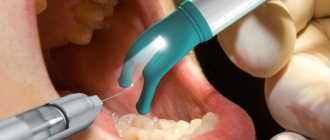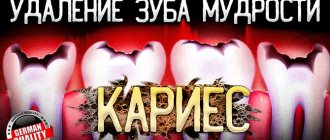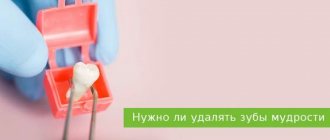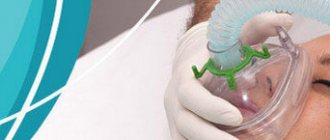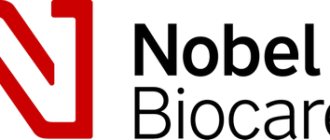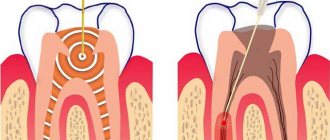Types of anesthesia in dentistry
Anesthesia in dentistry can be general or local. The first includes intravenous sedation, as well as general anesthesia. That is, the drugs do not act locally in the oral cavity, but throughout the entire body. Actually, this is ordinary general anesthesia, which is used everywhere in medicine - it’s just that certain types are used in dentistry. Local, as it is already becoming clear, includes the familiar “freezing”, which is administered by injection.
Separately, we can also distinguish xenon sedation or xenon therapy - the second name will be even more correct, since such anesthesia is used to prepare for local or general anesthesia. It allows you to reduce the level of anxiety and stress, saturates the body's cells with oxygen, due to which it has a general healing and even rejuvenating effect! It is not an independent type of pain relief, but is used in combination with other approaches.
Anesthesia methods
Anesthesia can be local or general. The local form is divided into external and injection methods. The external method allows you to anesthetize superficial tissues using medicinal substances. These can be special ointments, gels, devices with electromagnetic waves, simply applications. The last method is used most often. The application is a cooling plate. It is applied to the gums, and the patient does not feel pain. This method is usually used to remove baby teeth in children.
The injection method involves injecting an anesthetic substance through a needle.
There are 4 types of anesthesia:
- Conductor. The method allows you to anesthetize several teeth at once. An anesthetic is injected into the area of the last tooth where the branch of the nerve is affected, resulting in blockage of the entire nerve.
- Infiltration. An anesthetic substance is injected into the projection area of the apex of the tooth root.
- Intraligamentous. The medicine is administered through the gum. As a result, the tooth and the surrounding gum area are numbed. For this method, a special syringe with a dispenser is used. It allows you to administer a minimum of anesthetic substance.
- Intraosseous. It is the best anesthesia. In this case, the injection is made directly into the spongy bone. It is she who covers the dental alveoli.
General anesthesia (anesthesia) is done very rarely. It should not be used for people who have heart problems. This method of anesthesia is used only in the most difficult cases. Dentistry must be equipped with a special office and all the necessary equipment. And also during surgical operations, the presence of an anesthesiologist next to the patient is mandatory. Only the doctor decides which anesthesia is best for tooth extraction. Everything will depend on the complexity of the procedures and the general condition of the tooth.
Xenon sedation or xenon therapy to prepare for main anesthesia
This is a separate type of anesthesia that can be used in combination with both local and general anesthesia (if necessary). Xenon is an inert gas that quickly begins to act and is just as quickly eliminated from the body. It has a relaxing effect: anxiety decreases, the patient relaxes. Moreover, during the operation he is fully conscious, can communicate with the doctor, and understands everything that is happening around him. The procedure can be interrupted if necessary if there is discomfort. At the same time, local anesthetics are used, since xenon itself does not have a pronounced analgesic effect.
Among the pleasant “bonuses” are saturation of cells with oxygen and restoration of metabolic processes. That is, this is not only a reduction in stress, but also a general improvement in the body’s health.
General anesthesia in dentistry
With general anesthesia, the patient falls asleep for 1-2 hours or more, i.e. for the entire duration of treatment. The drug is administered intravenously, less often by inhalation. If possible, general anesthesia should still be avoided, since its effect on many organs is quite toxic. Even despite the fact that dentistry uses “lighter” drugs than during complex surgical operations. This is a fairly large load on the body, especially on the heart, nervous and cardiovascular systems.
Intravenous sedation
Intravenous sedation does not have such pronounced negative consequences for the body. Softer and gentler drugs are used here. Sedation puts a person into a half-asleep state - the patient can respond to the doctor’s commands, communicate and understand him. At the same time, the person is completely relaxed and may even fall asleep for several hours. Thus, intravenous sedation is a more gentle and safe type of pain relief.
This is interesting! The word “sedation” itself means “calming.” It can be carried out either by inhalation (nitrous oxide or safer and more effective xenon is used for this), as well as intravenously with the selection of drugs strictly individually.
We treat without pain and discomfort!
Intravenous sedation
Safe and pain-free Treatment in your sleep Quick recovery from RUB 8,000. from 8,000 rub.
Xenon sedation
Relaxation before treatment No stress on the body Recovery in 2-3 minutes from RUB 5,000. from 5,000 rub.
With us you will stop being afraid of dentists! Individual selection of drugs, the most modern equipment and certified doctors who professionally work with all types of anesthesia.
Enroll now
What is local anesthesia?
Local anesthesia allows you to numb the specific area where the intervention is planned. The patient is conscious. And this is actually more than enough even for complex surgical operations.
For local administration of all types of anesthetics, special reusable syringes are used, which have a recess for inserting a carpule - this is a hermetically sealed ampoule with an anesthetic. Unlike disposable ones, carpule syringes have a thinner needle, which allows you to administer the drug slowly and thus eliminate pain. All syringes for reusable use must undergo antiseptic treatment and sterilization using modern ultrasonic and temperature sterilization equipment.
Types of anesthesia used in dental practice
When treating the oral cavity and teeth, anesthesia is used - general or local.
Anesthesia (general anesthesia) is used quite rarely. With this anesthesia, the patient is unconscious while the treatment is underway and does not feel anything. Anesthesia (general anesthesia) is used only for major operations or when treating children. This type has too many contraindications and all sorts of complications, so dentists almost always prefer local anesthesia. This is the best option for dental intervention.
Local anesthesia - pain relief by freezing or injection into the gum. In this form, the anesthetic temporarily disables the sensitivity of pain in the area specified for treatment. Tactile sensations are preserved during local anesthesia. The patient feels touch or pressure on the tooth or gum, but the patient has no pain. To numb the patient's upper tooth, a local anesthetic is injected into the gum near the painful tooth. This is infiltration anesthesia. Lower teeth - by injecting the patient with a local anesthetic near the mandibular nerve. This will be a conduction anesthesia. It will lead to numbness of the tongue and lower jaw. In dental practice, there is also topical anesthesia, which will make treatment of a certain area of the oral mucosa painless by applying a special gel or spray to it. This anesthesia will be appropriate before infiltration anesthesia, so that the needle prick is imperceptible to the patient.
Infiltration anesthesia
Classic “freezing”, which is used in dentistry for almost any manipulation. The drug is injected under the mucosa, into the periosteum or directly into the bone. Depending on the procedure and the patient’s pain threshold, the required dosage is selected - for example, in case of acute pulpitis or complex tooth extraction, a higher concentration of the drug is used. If the patient is afraid of injections, topical anesthesia can additionally be used to numb the site of needle insertion, or xenon sedation.
When performing the procedure, the doctor must take into account the anatomy of the jaw system. For example, in the lower jaw the alveolar bone is denser, so anesthesia is less effective. In the upper jaw, when performing manipulations in the area of wisdom teeth, there is a risk of the needle touching one of the branches of the facial nerve, which is fraught with the development of neuralgia. The clinic’s doctors have the necessary qualifications, so even the most complex anesthesia is performed completely safely for the patient.
What care is required after tooth extraction?
Regardless of whether you had a simple or complex tooth extraction, such a situation requires monitoring your well-being and the wound surface on the gum. First of all, this concerns the proper healing of the hole. Ideally, a blood clot should form in it, which indicates that healing is proceeding without problems. It is for this purpose that the doctor immediately after the procedure places a gauze swab into the resulting cavity. It must be kept in the indicated place without removing it for 20-30 minutes, and only after that can it be removed. If the hole has formed correctly, then in a couple of days it will be covered with epithelium, and after a couple of months new bone tissue will appear in its place.
In order not to interfere with the proper healing of the wound, you must follow the following recommendations:
- Do not rinse your mouth for a couple of days or use a toothbrush in the area where the tooth was removed;
- For the first time after the procedure, avoid hot drinks and food;
- do not take a hot shower or bath for 2-3 days after tooth extraction;
- for the first few hours, completely abstain from food and drinks;
- Until the wound heals completely, try to chew on the other side of your mouth.
Many people experience swelling in the area where the tooth was removed, which can last for several days. To make it less pronounced, it is recommended to apply ice to the cheek after the procedure. Minor pain and low-grade fever may also be a concern. This is considered normal, and to alleviate the condition, the doctor prescribes painkillers. He may also prescribe an antibiotic if in a particular case he considers its use justified. In such a situation, it is extremely important to undergo a full course of treatment in strict accordance with the doctor’s recommendations.
Preparations for local anesthesia
The Smile-at-Once clinic uses modern anesthetics of the latest generation - effective, non-toxic and absolutely safe, even for pregnant women, the elderly or children. We do not use drugs based on novocaine or lidocaine due to toxicity and a high risk of allergic reactions. In addition, the articaine group of drugs, which are used today for local anesthesia, are 5-6 times more effective than lidocaine.
"Ultracaine" for all groups of patients
An original drug produced in France, which is used for both infiltration and conduction anesthesia.
It is safe, used even in the presence of allergic reactions, and is suitable for patients with heart disease and pregnant women. Its effectiveness is very high, while it is instantly eliminated from the body and does absolutely no harm. The main active ingredient is articaine, to which epinephrine is added to enhance the anesthetic and prolong its action. It provides local vasoconstriction, which significantly shortens the rehabilitation period after treatment. Depending on the concentration of epinephrine, there are three types of the drug - for different manipulations and categories of patients.
"Ultracaine-Forte" (concentration 1:100,000) is a drug with a high dose of epinephrine, used during surgical operations. "Ultracaine DS" with a low concentration (1:200,000) - is used for therapeutic treatment, including in patients with diseases of the cardiovascular system, high blood pressure, suitable for pregnant and lactating women. Ultracaine D does not contain epinephrine. The effect of the drug is short, but it can be used for allergic reactions, bronchial asthma, and pronounced cardiovascular pathologies.
"Ubistezin"
A cheaper, but no less high-quality analogue of Ultracain, produced by the German company 3M. It contains similar active ingredients: articaine hydrochloride and epinephrine. It has two forms of release, depending on the concentration of the latter (1:100,000 or 1:200,000). Use is allowed during breastfeeding and cardiovascular pathologies.
"Artikain"
An injection solution that consists directly of the main active ingredient - articaine. Inexpensive drug made in Russia. Used for infiltration or conduction anesthesia. Can be used in pure form or with the addition of epinephrine/glucose solution in a certain proportion. Not used for bronchial asthma and severe allergic reactions.
"Scandonest" for the elderly
The main active ingredient of this French-made drug is mepivacaine hydrochloride. It is not used during pregnancy and bronchial asthma, but use is allowed in patients with cardiovascular pathologies, since the drug does not contain epinephrine, adrenaline and preservatives. Suitable for older people, especially those with high blood pressure. It is one of the safest anesthetics for both infiltration and conduction anesthesia. Its disadvantage is its short duration of action, which requires repeated administration of the drug approximately every 30 minutes during long procedures.
"Orablock"
Another drug, the main active ingredients of which are articaine and epinephrine with varying concentrations of the latter, which affects the effect and duration of pain relief. Not used during pregnancy and pronounced cardiovascular pathologies.
"Naropin" for complex surgical operations
A long-acting anesthetic whose main active ingredient is ropivacaine hydrochloride. The duration of pain relief depends on the dosage. Very often, this drug is used for conduction anesthesia during complex surgical operations and the installation of a large number of implants. Among the contraindications is only individual intolerance to amide anesthetics.
When deletion is indicated
There are indications for which wisdom teeth are always removed. These include:
- Too dense arrangement of teeth is the so-called crowding of teeth. This leads to difficulties with the eruption of the wisdom tooth, as a result of which it grows crookedly and causes serious pain. When teeth are impacted, infectious and inflammatory processes in the oral cavity are often observed. These problems can only be solved by removing pathologically located wisdom teeth.
- When there is a malocclusion or crooked teeth, orthodontists most often prescribe the installation of braces. The process of wisdom teeth erupting displaces the entire dentition, and this can cause pain when wearing braces. To avoid this problem, wisdom teeth are removed in advance, even if the process of eruption has not yet begun.
- Dental diseases of the wisdom tooth (pulpitis, periodontitis, caries) become a common reason for its removal. Therapeutic methods for treating such a tooth are associated with serious difficulties, and the tooth itself does not provide any useful function. Therefore, you can get rid of a diseased wisdom tooth without regrets.
The wisdom teeth removal procedure can be performed under local or general anesthesia. Indications for the use of general anesthesia include:
- inadequate psychological state of the patient, panic;
- More than one tooth needs to be removed;
- gag reflex during dental procedures;
- allergy to local anesthesia.
To avoid an allergic reaction to general anesthesia, a full examination of the patient is carried out, the drug and dose are selected individually.
Removing wisdom teeth under general anesthesia has many contraindications. For example, general anesthesia cannot be used if the following pathologies are present:
- hormone-dependent diseases;
- acute neurotic and psychiatric diseases (epilepsy and others);
- various types of heart rhythm disturbances: slow cardiac activity, attacks of tachycardia with a heart rate of more than 140 beats per minute, atrial fibrillation with a rate of over 100 beats per minute;
- the presence of problems with blood circulation in the brain that began 6 months ago;
- myocardial infarction that occurred less than six months before surgery;
- unstable angina or stable, severe exertional angina;
- when the patient's diastolic blood pressure is above 110 mm Hg;
- uncompensated heart failure with pronounced swelling in the legs, weakness and severe shortness of breath;
- severe stenosis of the mitral or aortic heart valve;
- severe bronchial asthma;
- acute diseases of the respiratory system, accompanied by fever or cough;
- pneumonia;
- exacerbation of chronic bronchitis or acute bronchitis;
- drug or alcohol intoxication;
- tuberculosis, pneumonia, ARVI, exacerbation of bronchial asthma;
- diseases of the cardiovascular system, accompanied by damage to the heart muscle, circulatory disorders and sclerotic changes in blood vessels;
- impaired renal and liver function;
- hyperthyroidism, diabetes mellitus, adrenal insufficiency.
Pregnant women, as well as persons who have been vaccinated no earlier than two weeks before surgery, are also contraindicated in general anesthesia.
Indications and advantages of local anesthesia
Since local anesthesia is used everywhere, the indications for its use are very wide. Modern drugs are of very high quality and completely safe (especially if you use them thoughtfully, having first collected a high-quality anamnesis about the patient’s health condition). The level of stress from treatment without anesthesia, and especially with acute pain, can be prohibitive - very often after this, patients refuse to visit the dentist, causing dental problems. Do not be afraid of anesthesia - you will not receive such a “dose” of the drug that will harm you, even if you have to treat your teeth for several days in a row.
Indications for local anesthesia
- removal of dental plaque,
- dental treatment of any complexity,
- performing plastic surgery on gums,
- tooth extraction,
- surgical operations in the oral cavity,
- preparation and implementation of dental implantation.
Advantages
- complete relief of any painful sensations,
- safety, no toxic effects on the body,
- rapid elimination from the body,
- minimum side effects,
- the choice of drug based on the health status and age of the patient.
Safe and high-quality removal of wisdom teeth in Balashikha
The Berezka dental clinic offers qualified assistance to anyone who, for certain reasons, requires the removal of a wisdom tooth from above or below. The operations are performed by experienced surgeons using safe anesthesia and modern instruments.
Before the procedure, the dentist collects the patient’s medical history, conducts all the necessary examinations, and only if the clinical picture is present is it possible to extract the wisdom tooth.
The operation is performed in a comfortable environment for the patient. Innovative equipment and professional dentists ensure successful and safe removal of the most complex teeth.
Are there any disadvantages to local anesthesia?
Local anesthesia has virtually no disadvantages. Unlike drugs that were used previously, modern anesthetics are absolutely safe, have a minimum of contraindications, are quickly eliminated from the body, and do not have a negative effect on the heart, kidneys and liver. With professional administration, the patient will not feel any pain even during long surgical procedures.
“Our clinic uses a strictly individual approach. We have selected several of the most effective and safe drugs - for each patient we select our own method, drug and its concentration, based on individual characteristics. Therefore, everyone who undergoes treatment, implantation or prosthetics at the Smile-at-Once clinic can feel completely safe.”
Zhilenko Evgeniy Aleksandrovich, Implant surgeon, periodontist, orthopedist Work experience over 18 years make an appointment
Pros and cons of tooth extraction under anesthesia
Modern dental anesthesia is of two types: intravenous anesthesia and inhalation anesthesia. Inhalation anesthesia means that the patient is put into a state of anesthesia using gaseous drugs supplied through a mask. It is considered safe, but in any case its duration should not exceed one and a half hours.
The service of treatment and removal of teeth under general anesthesia is now available in any clinic, so it is worth considering the pros and cons of using general anesthesia in dentistry. Let's start with the pros:
- Saving time . Under anesthesia, you can perform not only tooth extraction, but also treatment, prosthetics, repair of fillings - and all in one session.
- No pain or fear . Local anesthesia does not always work 100%, and patients experience discomfort during treatment. And local anesthesia certainly does not relieve the fear of treatment and tooth extraction; only anesthesia can cope with this.
- Reducing the risk of inflammation . The use of general anesthesia for treatment and tooth extraction helps reduce the risk of developing alveolitis.
- The best quality of hardening of filling materials . When a dentist performs treatment or extraction of teeth under general anesthesia, he may use drugs that block salivation, which improves the quality of hardening of the filling material. This means that the fillings will hold better.
Now let’s look at the disadvantages of treatment and tooth extraction under anesthesia:
- Risk of negative effects on the body . Of course, in modern clinics the risk of negative effects of anesthesia on the body is minimal, but it exists. Those who have ever received general anesthesia are familiar with the state of recovery from anesthesia: nausea, dizziness, nervous agitation. And this is for a healthy person, but for those who have bronchial asthma or suffer from shortness of breath, have had a heart attack, or are simply elderly, anesthesia is contraindicated.
- Time limit . The flip side of this advantage is its disadvantage: diseases such as pulpitis or complicated caries are best treated gradually, over several visits. If anesthesia is used, the doctor is obliged to solve the problem in one visit: perform pulp removal, root canal filling, select photopolymers for the filling and check the bite. Due to lack of time and lack of feedback from the patient, the dentist may make a mistake. The most common occurrence in such cases is underfilling of the root canals, which leads to complications and even tooth extraction.
For the reasons described above, teeth should be treated and removed under general anesthesia only when necessary and by an experienced dentist.
Modern technologies for administering anesthesia
The pain of the anesthesia itself, as well as its effectiveness, depend 90% on the skill of the dentist. A professional doctor will make every effort and use various techniques to make the patient feel comfortable. However, all people are different, each has their own pain threshold, and that is why an individual approach not only to the concentration of drugs, but also to premedication before the direct administration of anesthesia is very important.
Today, special anesthesia devices have been developed to help doctors. Naturally, they work under the supervision of a specialist. The electronic system is equipped with special pressure sensors - to avoid pain, the anesthetic must be injected very slowly and immediately after puncturing the tissue. The device is equipped with special needles with a very thin double tip, which again reduces pain.
In addition, by administering a small dose of anesthetic, a kind of allergy test is performed - the doctor assesses the condition of the soft mucous membranes (swelling, redness, rash) and the patient’s general reaction, and the pressure force is controlled by the device.
Safe, painless and effective treatment without pain! Treatment is carried out under the supervision of anesthesiologists capable of providing first aid. Special equipment monitors indicators of the general condition of the body.
If there is any threat, the ambulance station is 800 meters from the clinics! You are under the reliable protection of professionals.
Enroll now
Possible complications after tooth extraction
In some cases, tissue healing after tooth extraction does not occur correctly, or an infection is observed. In this situation, we talk about complications after surgery. They are indicated by severe pain, great swelling, and elevated temperature. If pathogenic microflora gets into the wound, then bad breath and purulent discharge may also appear. The listed symptoms may indicate a cyst or fistula.
A common complication after tooth extraction is alveolitis. This condition is accompanied by a dry socket, that is, the absence of a blood clot. The main sign of pathology is quite severe pain. Alveolitis is most often diagnosed in women taking contraceptives and in people who smoke.
The development of complications after tooth extraction is often a consequence of neglecting the doctor’s recommendations. In addition, the reason may be related to poorly performed manipulation or low qualifications of the doctor. That is why it is always important to contact experienced specialists who master modern techniques and cope well with even the most complex and extraordinary cases.
come back
The use of anesthesia for health pathologies
- diabetes mellitus, bronchial asthma, allergic reactions: anesthetics without preservatives and with a minimal amount of epinephrine are used. For these problems, medications are selected strictly individually, most often based on the results of additional tests,
- high blood pressure, heart disease: with minimal or no epinephrine. It is also important that anesthetics do not contain adrenaline. For these pathologies, intravenous or xenon sedation can be used,
- pregnancy and lactation: drugs with a low content of epinephrine - in minimal dosages, the active substance does not cross the placenta and practically does not enter breast milk (only in small quantities, but this does not have any negative effect, so after dental treatment you can not skip feeding and no need to express milk). It is important that the drugs cannot be used without the addition of the vasoconstrictor epinephrine - in this case, the vessels remain open and the active substance will quickly spread throughout the body, which increases the risk of its transmission to the fetus or child through breast milk.
Sedation and anesthesia - is it safe?
Yes, if they are carried out by professional doctors who have extensive experience and have undergone appropriate training (and a license is also required to perform general anesthesia - this requires an anesthesiologist-resuscitator), then the procedure will be completely safe. In addition, for complex and long-term implantation, the use of sedation is even preferable - you are less tired, you do not need to focus on keeping your mouth open for several hours and fixing your head in a certain position. For you, 3-4 hours of surgery passes in an instant. You will be under the supervision of specialists, and before the operation you will undergo a fairly extensive list of tests for high-quality preparation for treatment and selection of the most suitable, safe drug.
1 Zoryan E.V. Errors and complications when performing local anesthesia in dentistry, 2007.
Preventive measures
In order for the rehabilitation period to pass faster and to avoid negative consequences, the following recommendations must be followed:
- No later than 10 minutes after a sterile swab has been applied to the wound, it must be removed from the oral cavity. This will avoid infection and inflammation.
- You cannot eat for three hours after surgery and anesthesia. If thirst occurs, you can drink clean water.
- Physical activity and hot water procedures (including shower, bath, sauna, steam bath) are contraindicated for a couple of days after surgery. You should also not heat your cheek.
- You should not smoke or drink alcohol for several days, this will help prevent the seams from coming apart.
- If the patient is experiencing severe pain, an ice compress will help reduce the pain. You can apply cold for no more than five minutes. The doctor may also prescribe pain relievers.
- The patient must take all prescribed medications.
A few days after the operation, you need to see your doctor, and if you experience unpleasant or severe pain, then sooner.
In our clinics, general anesthesia is not used.
